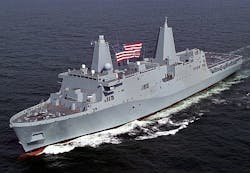Raytheon to provide shipboard electronics for Navy's 11th San Antonio-class expeditionary warfare ship
WASHINGTON, 2 March 2012. Military shipboard electronics designers at the Raytheon Co. Integrated Defense Systems segment in San Diego will design and build the integrated shipboard electronics systems for the U.S. Navy's eleventh San Antonio-class amphibious transport dock warship, which will be built at Ingalls Shipbuilding in Pascagoula, Miss.
Raytheon won a $55.1 million contract modification Thursday to provide shipboard electronics for the LPD 27 amphibious transport dock ship, which is yet unnamed. San Antonio-class ships deploy U.S. Marines and their equipment. The ships are 684 feet long and carry as many as 800 Marines. Awarding the contract to Raytheon were officials of the Naval Sea Systems Command in Washington.
Raytheon will provide the LPD 27's engineering control system; magnetic signature control system; ship control system; navigation data distribution system; shipboard wide-area network; wire-free portable communication system; integrated voice communication system; sensors; Marine Corps support equipment; and AN/SPS-73 surface search radar system.
Ingalls Shipbuilding, a division of Huntington Ingalls Industries, won a $70 million contract modification last week for long-lead-time materials to build LPD 27, such as main engines, diesel generators, electrical switchboards, deck equipment, and fire extinguishing systems, reported April Havens in The Mississippi Press of Pascagoula, Miss.
The Raytheon Shipboard Wide Area Network (SWAN) is at the heart of the Navy's San Antonio-class expeditionary warfare ships. SWAN provides digital communications among users and shipboard systems, as well as a redundant network computer architecture.
While previous generations of naval warships connected shipboard systems on dedicated cabling and isolated networks, Raytheon's SWAN integrates shipboard systems centrally on one survivable network.
SWAN integrates combat systems, navigation, C4I, e-mail, and administrative data with ship, magnetic signature and engineering control systems signals, Raytheon officials say. SWAN uses fiber-optic cabling, a 10 Gigabit Ethernet network, modular server hardware, and commercial off-the-shelf software.
SWAN's Gigabit Ethernet network delivers sub-second failure recovery times to help legacy systems to function without interruption, and helps the ship remotely manage and monitor system status in near real time. The fiber-optic network has more than 762 fiber optic drops.
The San Antonio-class ships are replacing the Navy's Austin-, Cleveland-, and Trenton-class amphibious transport dock ships, as well as the Anchorage-class dock landing ships, Newport-class tank landing ships, and the now-retired Charleston-class amphibious cargo ships.
The ship can carry landing craft air cushioned (LCAC) boats, has sit-up berthing for deployed Marines, ship services mall, and learning resource center/electronic classroom.
For more information contact Raytheon Integrated Defense Systems online at www.raytheon.com/businesses/rids, Ingalls Shipbuilding at www.huntingtoningalls.com/is, or Naval Sea Systems Command at www.navsea.navy.mil.

